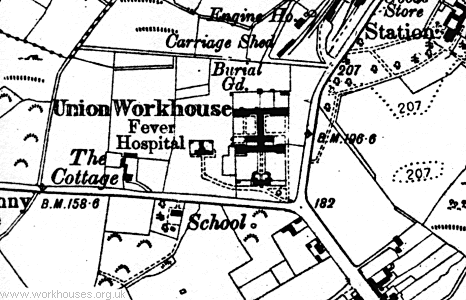Glenties, Co. Donegal
Glenties Poor Law Union was formed on the 2nd August 1841, and was the last of Ireland's original 130 Unions to be declared. It was also Ulster's largest Union in area, covering an area of 407 square miles. Its operation was overseen by an elected Board of Guardians, 23 in number, representing its 14 electoral divisions as listed below (figures in brackets indicate numbers of Guardians if more than one):
Co. Donegal: Ardara (2), Derryloaghan, Dunglow (2), Fintown, Glenties (2), Kilcar (2), Kilgoly, Killybegs (2), Lettermacaward, Malinbeg (2), Menavally, Mullaghderg, Naran (2), Rutland (2).
The Board also included 3 ex officio Guardians, making a total of 26.
The population falling within the union at the 1831 census had been 31,752 with divisions ranging in size from Fintown (population 560) to Killybegs (4,693) and Glenties itself (1,547).
The new workhouse, built in 1844-5 at the north-west of Glenties, was designed by George Wilkinson. It occupied a eight-acre site and could accommodate 500 inmates. The cost of the building was £5,100 plus £940 for fixtures and fittings etc. It was declared fit for the admission of paupers on 22nd September 1845, and admitted its first inmates ten months later on 24th July 1846. The workhouse location and layout are shown on the 1907 map below.

Glenties workhouse site, 1907.
The workhouse followed one of Wilkinson's standard designs, with a front block housing receiving rooms on the ground floor and a board-room on the first floor. A central block housed dormitories, school rooms, day rooms, kitchen and food serving rooms. The rearmost block, connected via the workhouse chapel, housed the workhouse infirmary. A separate fever hospital was later erected at the west of the workhouse. A burial ground lay to the north.
The workhouse later became Glenties District Hospital. The buildings were demolished in 1960 and the site is now occupied by Glenties Comprehensive School.
Records
Note: many repositories impose a closure period of up to 100 years for records identifying individuals. Before travelling a long distance, always check that the records you want to consult will be available.
- Donegal County Record Office, Three Rivers Centre, Lifford, County Donegal. Holdings include: Guardians' Minutes (1840-1922); Guardians' Rough Minutes (1848-1850); Admissions and discharges (1851-1867, 1884-1896, 1913-1921); Indoor Relief Register (1899- 1907, 1914-1921); etc.
Bibliography
- The Workhouses of Ulster by Michael H Gould, 1983.
- The Workhouses of Ireland by John O'Connor (Anvil Books, 1995)
Links
- None.
Unless otherwise indicated, this page () is copyright Peter Higginbotham. Contents may not be reproduced without permission.


